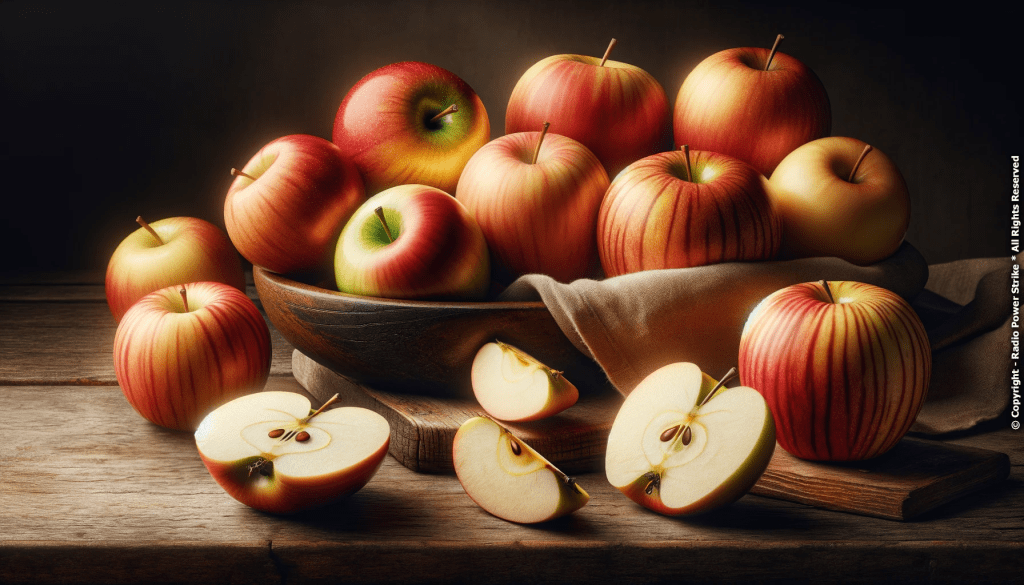
Apples, celebrated globally for their crisp texture and sweet-tart flavor, have been a symbol of health and nutrition for centuries. This guide unveils the mysteries of apples, providing a comprehensive look at their origin, varieties, and benefits.

Origin
Apples are believed to have originated in Kazakhstan’s mountainous regions. These ancient apples were not the sweet, crisp fruits we know today but were smaller and more bitter. Over centuries, through cultivation and natural selection, apples evolved into the delicious and varied fruit enjoyed worldwide.
The apple’s journey from Kazakhstan to the rest of the world is a tale of exploration and discovery. Traders and travelers carried apples along the Silk Road, introducing them to different regions. With time, the cultivation of apples spread, and they became a staple in various cultures, celebrated for their delightful taste and nutritional value.
Today, apples are grown in over 100 countries, with China, the United States, and Poland being the top producers. The global appreciation for apples is evident in their ubiquitous presence in markets, kitchens, and culinary traditions around the world.
Varieties
With over 7,500 known varieties, apples offer a flavor, texture, and color to suit every palate. The Fuji apple, known for its sweetness and crunch, is a favorite among those who enjoy fresh, raw apples. For those who prefer a tart flavor, the Granny Smith apple, with its distinctive green skin and sour taste, is an ideal choice.
The Honeycrisp apple is another popular variety, celebrated for its perfect balance of sweetness and tartness, and its exceptionally juicy and crisp texture. Each apple variety has its unique set of characteristics, making them suitable for different uses, whether it’s for eating fresh, baking, cooking, or making cider.
Different apple varieties also have different harvest seasons, which means that you can enjoy fresh apples year-round. From the early harvest varieties like the Paula Red to the late harvest ones like the Pink Lady, there’s always a delicious apple to be found at your local grocery store or farmer’s market.
Properties
Apples are a powerhouse of nutrition, offering a host of health-promoting properties. They are rich in essential nutrients, antioxidants, and dietary fiber, all while being low in calories. The antioxidants in apples, including Vitamin C and various polyphenols, play a crucial role in protecting against chronic diseases.
The dietary fiber in apples, particularly the soluble fiber called pectin, aids in digestion and helps regulate blood cholesterol levels. Apples are also a good source of several B-vitamins, potassium, and vitamin K, all of which are essential for maintaining good health and well-being.
Furthermore, apples have a low glycemic index, which means that they release sugar into the bloodstream slowly, providing a steady source of energy without causing spikes in blood sugar levels. This makes them a suitable snack for individuals managing diabetes or those looking to maintain stable energy levels throughout the day.
Benefits
Regular consumption of apples offers a myriad of health benefits. The high fiber content aids in digestion, promoting a healthy gut and preventing constipation. The antioxidants found in apples, including quercetin, catechin, and chlorogenic acid, help protect the body’s cells from damage caused by free radicals.
Apples also play a role in heart health. The soluble fiber helps lower blood cholesterol levels, while the antioxidants may help lower blood pressure and reduce the risk of stroke. Furthermore, the consumption of apples has been linked to a lower risk of type 2 diabetes, thanks to their low glycemic index and high fiber content.
For those looking to maintain a healthy weight, apples can be a valuable addition to the diet. Their high water and fiber content help you feel full, making them a satisfying snack that can aid in weight management. With their delightful taste and crunch, apples are a pleasure to eat while supporting your health and wellness goals.
Nutritional Value

A medium-sized apple, weighing about 182 grams, provides approximately 95 calories, making it a low-calorie snack option that’s packed with nutrients. It delivers around 4 grams of dietary fiber, which is 14% of the recommended daily value, supporting digestive health and promoting feelings of fullness.
Apples are also a good source of vitamin C, providing about 14% of the daily value. Vitamin C is an essential antioxidant that supports immune function, aids in the absorption of iron from plant-based foods, and promotes healthy skin. Additionally, apples offer small amounts of vitamin A, calcium, and iron.
The polyphenols in apples, which are responsible for many of their health benefits, are not listed on nutritional labels. These compounds have antioxidant and anti-inflammatory effects, and they are found in both the flesh and skin of the apple. For maximum health benefits, consider eating apples with the skin on, but be sure to wash them thoroughly first.
Storage and Consumption Tips
Choosing Apples
Select apples that are firm, bright, and free of bruises. The skin should be tight, not wrinkled, indicating freshness.
Storing Apples
For short-term storage, keep apples in a cool, dry place. For longer storage, refrigerate them in the crisper drawer.
Washing Apples
Rinse apples under cold running water just before eating or cooking. There’s no need to use soap or other cleaning products.
Preventing Browning
After cutting, prevent apples from browning by sprinkling them with a little lemon juice or soaking them in a mixture of water and lemon juice.
Enjoying Apples
Apples can be enjoyed in various ways: eaten raw, added to salads, baked into pies, or cooked into sauces and jams.
Fun Facts
Apple Trees
Apple trees can take up to 8 years to produce fruit after being planted from seed, and they can live for over 100 years.
World’s Top Producer
China is the world’s top producer of apples, contributing to over 50% of the total global production.
Apple in Culture
The apple has been a symbol of knowledge, immortality, temptation, and the fall of man in various mythologies and religions.
Number of Apples
It takes about 36 apples to create one gallon of apple cider.
Largest Apple
The largest apple ever picked weighed about 3 pounds and 2 ounces, and it was harvested in Hirosaki City, Japan in 2005.

Comments are closed, but trackbacks and pingbacks are open.